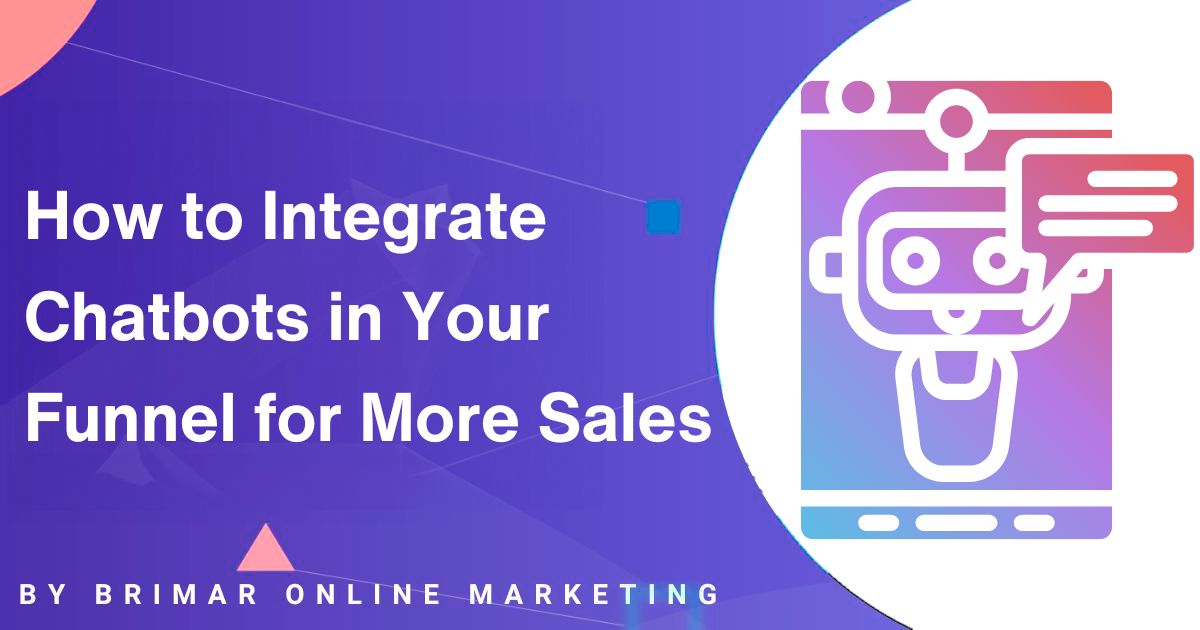
Chatbots have quietly become one of the most powerful tools in modern marketing.
With advances in artificial intelligence and machine learning, AI-powered chatbots are no longer just scripted helpers.
They can understand customer needs, guide users through complex decisions, and even recommend the right products in real-time.
They now play a crucial role in shaping meaningful customer interactions, nurturing qualified leads, and driving business growth.
Instead of forcing your sales team to juggle countless repetitive tasks, chatbots handle those routine conversations, freeing up sales reps to focus on more strategic sales conversations and building relationships.
A well-crafted chatbot funnel does more than respond to queries.
It creates a personalized experience that feels natural, efficient, and helpful, all while collecting valuable customer data to improve your marketing funnel over time.
Why Use Chatbots in Your Marketing Funnel?
A customer’s journey through your funnel isn’t linear.
People come in at different stages, with different questions, pain points, and expectations.
That’s where chatbots shine; they meet visitors at any stage, understand what they’re looking for, and guide them to the next step without friction.
At the top of the funnel, chatbots engage website visitors and potential customers as soon as they land on your site.
They can greet them, qualify leads by asking simple questions, and offer relevant content or free trials to spark interest.
In the middle of the funnel, chatbots maintain the conversation by answering specific questions, recommending products, and helping tailor to customer needs.
They help collect detailed customer data, such as preferences, pain points, and buying signals, which your sales team can use to craft a more effective follow-up.
At the bottom of the funnel, chatbots help close sales by guiding users through purchase decisions, providing real-time product recommendations, and even scheduling calls with a sales representative if human intervention is needed.
One of the biggest advantages of using chatbots is their ability to provide immediate responses, no matter the time of day.
Unlike human agents, they’re available 24/7, offering customer support and resolving simple issues even outside of business hours.
This kind of always-on support keeps potential customers engaged at the right moment, reduces response times, and creates a seamless user experience that moves people smoothly through the funnel.
It also helps businesses gather valuable insights into customer behavior at every stage; insights that are typically difficult to obtain otherwise.
By automating repetitive tasks and answering common questions instantly, chatbots enable your sales reps to focus on what they do best: engaging in meaningful sales conversations and building trust with qualified leads.
Need a Sales Funnel that Converts?
Struggling to turn clicks into customers?
A high-converting sales funnel could be the missing link. We’ll help you build a simple, straightforward, and effective funnel that guides your visitors step-by-step, so they take action, not just browse.
Types of Chatbots You Can Use
Not all chatbots are created equal, and that’s a good thing.
Different types serve different roles depending on where your customer is in the funnel and what their needs are.
Here’s a breakdown of the main types you can use effectively.
Lead generation chatbots
These are perfect for collecting contact information and qualifying potential leads without requiring people to fill out cumbersome forms.
They engage website visitors in a natural conversation, ask the right questions, and even help filter out unqualified prospects before they reach your sales team.
Think of them as a friendly greeter who also keeps track of everyone who’s genuinely interested.
Sales chatbots
When someone is ready to make a decision, sales chatbots can step in to assist.
They handle real-time sales conversations, recommend products based on customer needs, and even send follow-up messages to visitors who leave without making a purchase.
They keep the conversation going and guide users toward the next step, boosting conversions without needing a sales rep to be online.
Customer service and virtual assistants
For customers who have questions or encounter problems, these chatbots serve as the initial point of contact.
They can resolve common issues, direct people to the relevant knowledge base articles, and escalate more complex issues to a human agent when necessary.
This not only improves customer satisfaction but also keeps your human support team focused on higher-value interactions.
Conversational AI vs. rule-based chatbots
Here’s where technology makes a difference.
Rule-based chatbots operate on straightforward scripts and manage basic, repetitive tasks.
They’re easy to set up but limited in what they can do.
Conversational AI chatbots, on the other hand, use machine learning, natural language processing, and predictive analytics to understand intent, respond in a more human-like way, and even anticipate customer needs.
These AI-powered chatbots can adapt over time and handle much more complex conversations.
Examples in action
You have numerous options to fit your strategy, including custom AI chatbots tailored to your funnel, live chat tools for immediate interactions, digital assistants embedded into your website, AI agents managing sales conversations, and AI-powered chatbots integrated into messaging platforms like Facebook Messenger.
Each of these tools offers unique strengths, enabling you to select the one that best aligns with your customer journey.
Key Benefits of Integrating Chatbots

Once you start using chatbots effectively, the impact on your business is hard to miss.
Here are the benefits you can expect when you integrate them into your funnel.
Better customer experience and engagement
Chatbots keep visitors engaged by delivering relevant content and tailoring conversations to each person’s needs.
They help guide users smoothly through your website, making the whole experience feel more personal and less like clicking around aimlessly.
Faster responses, real-time support
Nobody likes waiting for answers, and with chatbots, they don’t have to.
Whether it’s a quick product question or help finding the right information, chatbots respond instantly, keeping engagement high and customers happy.
Relieve your sales team
Your sales reps have limited time, and chatbots help them focus where it matters most.
By automating repetitive tasks and handling straightforward conversations, chatbots enable your team to step in only when human interaction is truly essential, such as closing a major deal or resolving a complex issue.
Boost conversions and generate better leads
When you engage people at the right moment with relevant information and immediate assistance, you create more opportunities to convert them into customers.
Chatbots help you qualify leads early, guide them through the funnel, and ultimately increase your conversion rates.
Gain valuable data and insights
Every interaction with a chatbot provides data about customer behavior, questions, pain points, and more.
You can analyze this to optimize your sales funnel, create more effective campaigns, and tailor your messaging to meet your audience’s actual needs.
These data-driven insights give you a competitive edge and help improve results over time.
Best Practices for Chatbot Integration

Getting the most out of a chatbot isn’t just about plugging it into your site and hoping it works.
You need a clear strategy and a few thoughtful moves to make it truly impactful.
Begin by clearly identifying your target audience.
Identify your target audience, understand their customer journey, and map out both their broad needs and specific challenges.
The more you understand what they’re looking for, the easier it is to design a chatbot that helps them, rather than frustrating them.
Next, select a chatbot platform and AI tools that integrate seamlessly with your existing systems.
Look for options that integrate seamlessly with your website, messaging platforms, and social media accounts.
A chatbot that works well across channels ensures customers have a consistent experience, no matter where they interact with you.
Once it’s live, focus on guiding users with relevant information at just the right time.
Whether they’re browsing a product page, comparing services, or seeking support, your chatbot should anticipate their needs and provide meaningful assistance, rather than generic responses.
And don’t forget there are moments when only a human can solve the problem.
For complex issues, always offer a smooth hand-off to a sales representative or customer service agent.
Let your chatbot handle the repetitive tasks, but keep the human touch where it matters most.
Use your chatbot as more than a simple Q&A machine.
It can also share blog posts, case studies, detailed product information, and even point visitors to your knowledge base.
This positions it as a helpful guide rather than just a sales bot.
Finally, treat your chatbot like an evolving member of the team.
Test and refine it regularly using real case study insights, user interaction data, and customer feedback.
This ongoing optimization ensures that your chatbot stays aligned with customer expectations and continues to deliver measurable value.
Choosing the Right Chatbot for Your Business
Not every chatbot fits every business, and that’s a good thing.
The right chatbot feels like a natural part of your team, supporting your sales processes, connecting with your target audience, and solving customer needs without friction.
Start by looking at your goals.
If your sales team spends too much time answering repetitive questions, an AI-powered sales chatbot can handle those conversations and free up your human agents to focus on complex issues and closing deals.
If your priority is capturing potential leads, a lead generation chatbot is ideal for collecting contact information, qualifying prospects, and handing off qualified leads to your sales reps at the right moment.
For broader support tasks, a digital assistant or virtual assistant can guide users, recommend products, and help across different stages of the sales funnel.
It also helps to match the chatbot to the stage of the funnel you want to improve.
Early in the funnel?
Focus on user engagement, offering relevant content, and collecting customer data.
Mid-funnel?
Guide users to specific solutions, answer detailed questions, and recommend the next step.
Near conversion?
Provide immediate responses, address pain points, and hand off to a sales agent if needed.
Finally, evaluate the AI technology itself.
Look for chatbot platforms that combine conversational AI, natural language processing, and predictive analytics, allowing the bot to understand customer interactions and adapt over time.
If your business has particular needs, a custom AI chatbot built on your knowledge base and integrated with your sales tools can deliver a truly personalized experience.
Final Thoughts

Chatbots have quietly become an essential tool for businesses that prioritize growth, customer satisfaction, and improved results.
They offer immediate responses, handle repetitive tasks, and improve the user experience without replacing the human touch where it’s needed most.
They meet potential customers where they are on websites, messaging platforms, and social media and guide them through the customer journey with relevant information, valuable insights, and seamless support.
If you want to offer quick answers, improve customer interactions, and optimize your marketing funnel, now is the time to put AI-powered tools and chatbot technology to work for you.
Start your free trial of a powerful chatbot platform today, test your chatbot funnel, and see how it can transform your customer engagement and sales.
The next stage of your business growth could be just one conversation away.
Our Digital Marketing Services Have Helped Our Clients Increase Their Revenue!
“I highly recommend Brimar if your looking to grow your online business. You will be satisfied with the high level of expertise and high quality of services. It has helped my business grow by leaps and bounds.”
CEO
